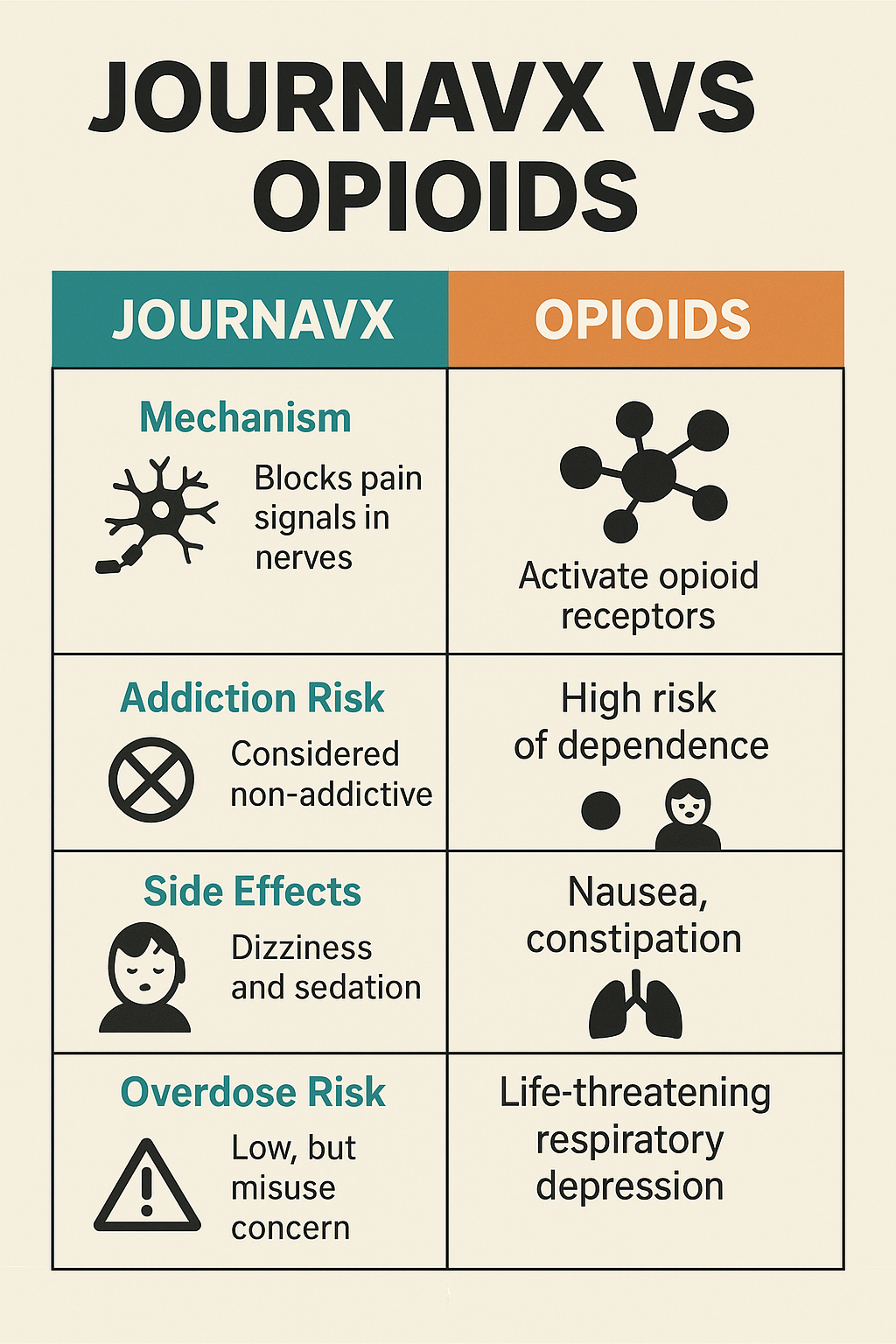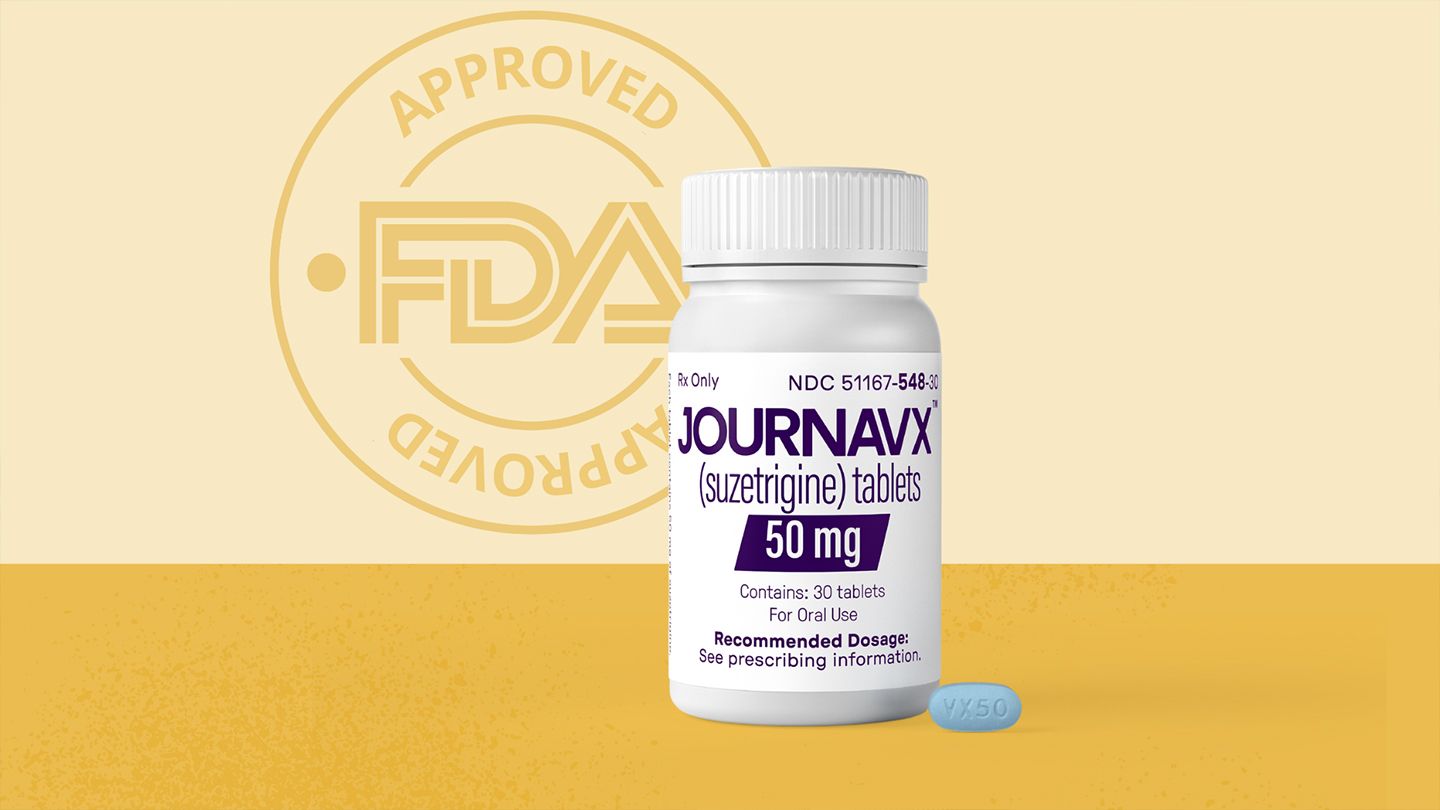Journavx (suzetrigine) is a non-addictive painkiller approved for acute pain management. It offers an alternative to opioids, blocking pain signals without the addiction risk. Its advantages include fewer side effects like itching or muscle spasms compared to opioids, but it has some drawbacks, such as limited long-term data and potential side effects like nausea and liver issues. Ethical concerns involve its high cost, accessibility, and over-reliance on medication for pain. While effective, side effects like fatigue and allergic reactions require careful monitoring during use.
Journavx (Suzetrigine): A Breakthrough Non-Opioid Pain Reliever
Pain management has long been dominated by opioid-based treatments, often accompanied by significant risks of addiction and adverse effects. In a major breakthrough, Vertex Pharmaceuticals has developed Journavx (suzetrigine), a newly approved non-opioid analgesic designed to provide effective relief for moderate to severe acute pain in adults.
How Journavx Works
Unlike traditional opioids, which act on the brain’s opioid receptors, Journavx works by selectively blocking the NaV1.8 sodium channel located on pain-sensing nerve cells. By inhibiting pain signals before they reach the brain, this novel mechanism significantly reduces the risk of addiction associated with opioid medications.
Clinical Efficacy and Safety
Clinical trials have demonstrated that Journavx provides pain relief comparable to commonly prescribed opioid combinations such as hydrocodone/acetaminophen. Additionally, patients using Journavx reported fewer opioid-associated side effects, including itching, muscle spasms, and rashes, making it a potentially safer alternative for acute pain management.
Dosage and Administration
The recommended dosage regimen for Journavx begins with an initial 100 mg dose taken on an empty stomach, followed by 50 mg every 12 hours. Patients should be aware that the drug is contraindicated in individuals taking strong CYP3A inhibitors, as these medications can interfere with its metabolism. Caution is also advised for those with liver impairments.
Availability and Cost
Journavx is available by prescription and is expected to be priced at approximately $15.50 per pill. Recognizing the financial burden of prescription medications, Vertex Pharmaceuticals has announced plans to offer assistance programs for eligible patients who may struggle to afford the medication.
Future Prospects
While Journavx shows significant promise for acute pain management, further research is needed to determine its efficacy in treating chronic pain conditions. As the medical community continues to explore non-opioid alternatives, Journavx represents a hopeful step forward in addressing pain without the risk of addiction.
With its innovative mechanism and encouraging clinical outcomes, Journavx could reshape the landscape of pain management, offering patients a safer and effective alternative to traditional opioids.
Journavx (Suzetrigine): A Breakthrough Non-Opioid Pain Reliever
Pain management has long been dominated by opioid-based treatments, often accompanied by significant risks of addiction and adverse effects. In a major breakthrough, Vertex Pharmaceuticals has developed Journavx (suzetrigine), a newly approved non-opioid analgesic designed to provide effective relief for moderate to severe acute pain in adults.
Key Advantages of Journavx
1. Non-Addictive
Advantage: One of the most significant benefits of Journavx is that it is not addictive. Unlike opioids, which can lead to dependency and abuse, Journavx does not have the same addiction potential, making it a safer option for pain management, especially in patients with a history of substance abuse or those at risk of addiction.
2. Reduced Side Effects
Advantage: Journavx has been shown to have fewer side effects compared to traditional opioids. For example, it causes less itching, muscle spasms, and rashes—common side effects of opioid use. This contributes to better overall patient comfort during treatment.
3. Effective Pain Relief
Advantage: Clinical trials indicate that Journavx provides effective pain relief comparable to opioid-based medications like hydrocodone/acetaminophen combinations. This allows individuals to manage moderate to severe pain without relying on addictive substances.
4. Mechanism of Action
Advantage: Journavx works by selectively blocking the NaV1.8 sodium channel on pain-sensing nerve cells. This mechanism helps to inhibit pain signals before they reach the brain, offering a targeted approach to pain management. It addresses pain at its source rather than masking it, offering potentially longer-lasting relief.
5. Fewer Prescription Barriers
Advantage: Since Journavx is non-addictive and has fewer side effects, it may be prescribed more freely than opioids, which often require more stringent regulations. It also offers a viable alternative for patients who cannot take opioids due to a history of addiction, opioid sensitivity, or other health concerns.
6. Safer for Long-Term Use
Advantage: Because it is non-addictive and has a safer side-effect profile, Journavx may be a better option for individuals who need long-term pain management but want to avoid the risks associated with chronic opioid use.
7. Cost Assistance Programs
Advantage: Vertex Pharmaceuticals offers assistance programs for individuals who cannot afford the medication, making it more accessible to a broader population. This is especially important for patients who may struggle with the high costs of healthcare.
Dosage and Administration
The recommended dosage regimen for Journavx begins with an initial 100 mg dose taken on an empty stomach, followed by 50 mg every 12 hours. Patients should be aware that the drug is contraindicated in individuals taking strong CYP3A inhibitors, as these medications can interfere with its metabolism. Caution is also advised for those with liver impairments.
Potential Disadvantages of Journavx
1. Limited Long-Term Efficacy Data
Disadvantage: Journavx has been approved for acute pain management, but its effectiveness for chronic pain conditions is still under investigation. Long-term data on its safety and efficacy in managing ongoing pain or its impact over extended use are limited, meaning its role in chronic pain treatment remains uncertain.
2. Potential Side Effects
Disadvantage: Although Journavx has fewer side effects compared to opioids, it may still cause some adverse effects, such as nausea, dizziness, and liver-related issues, particularly in individuals with pre-existing liver conditions. The medication should be used with caution in patients with liver impairments.
3. CYP3A Inhibition Interactions
Disadvantage: Journavx is contraindicated for individuals who are taking strong CYP3A inhibitors, as these medications can interfere with how Journavx is metabolized in the body. This could increase the risk of side effects or reduce the medication’s effectiveness.
4. Price
Disadvantage: At an estimated cost of $15.50 per pill, Journavx can be expensive, especially for those who need long-term or repeated doses. While Vertex Pharmaceuticals offers assistance programs, the price may still be a barrier for some individuals without access to these programs or adequate insurance coverage.
5. Narrow Indication
Disadvantage: Journavx is currently approved only for acute pain management in adults. It may not be suitable for individuals with different types of pain, such as those requiring ongoing or long-term pain relief. Its narrow indication limits its applicability for broader pain management needs.
6. New Drug with Limited Public Experience
Disadvantage: As a newly approved medication, Journavx has not been widely used in the general population. There is always a degree of uncertainty when new drugs enter the market, especially concerning potential long-term effects, interactions with other medications, or unforeseen side effects.
7. Not Suitable for Everyone
Disadvantage: Journavx may not be suitable for individuals with certain medical conditions, such as severe liver disease, or those on specific medications that interact negatively with it. Additionally, its use may be limited to specific pain types, restricting its overall use in the broader population.
8. Over-Reliance on a Single Medication
Disadvantage: While Journavx offers an alternative to opioids, relying solely on it for pain management without addressing the underlying causes of pain or incorporating other therapeutic strategies (such as physical therapy, lifestyle changes, or complementary treatments) could limit overall recovery or pain management effectiveness.
In summary while Journavx offers a promising non-addictive pain relief option, its limitations, such as potential side effects, limited long-term data, and high cost, should be carefully considered when determining if it is the right choice for pain management.
Ethical Considerations Surrounding Journavx
1. Accessibility and Cost
Ethical Dilemma: Journavx is priced at $15.50 per pill, which may make it inaccessible to individuals who lack insurance coverage or financial resources. While Vertex Pharmaceuticals offers assistance programs, not all patients will have access to them, raising concerns about equity in healthcare access.
Consideration: Should life-altering medications be priced in a way that ensures equitable access for all patients, regardless of their financial situation?
2. Over-Reliance on Medication
Ethical Dilemma: The availability of Journavx as a non-addictive painkiller might encourage over-reliance on pharmaceutical solutions for pain management, rather than exploring other holistic, non-pharmacological approaches.
Consideration: Should healthcare systems prioritize holistic treatment approaches, and how can they avoid the temptation of a “quick fix” mentality with medications like Journavx?
3. Long-Term Safety and Unknown Effects
Ethical Dilemma: Journavx is a new drug, and its long-term effects have not been fully studied, especially for chronic pain conditions.
Consideration: Should the potential benefits of a new medication be weighed against the risks of unknown long-term effects, and how much should companies disclose about these uncertainties to the public?
4. Use in Vulnerable Populations
Ethical Dilemma: The use of Journavx in populations such as those with liver impairments or individuals on other specific medications could present a risk.
Consideration: Is it ethical to promote the use of a medication for pain management in vulnerable populations when its risks are not fully understood?
5. Lack of Comprehensive Alternatives
Ethical Dilemma: Although Journavx offers a non-addictive alternative to opioids, it is primarily approved for acute pain and does not yet have evidence for chronic pain management.
Consideration: Should healthcare providers be ethically responsible for ensuring that patients with chronic pain have access to a broad range of pain management strategies?
6. Pressure on Doctors to Prescribe
Ethical Dilemma: The approval of Journavx might create pressure on healthcare professionals to prescribe it widely, even in cases where it might not be the best treatment option.
Consideration: How can healthcare providers ensure they make ethical prescribing decisions, considering both the patient’s unique needs and the potential risks and benefits of a new medication like Journavx?
7. Commercialization vs. Public Health
Ethical Dilemma: The commercialization of a drug like Journavx can lead to conflicts between maximizing corporate profits and prioritizing public health needs.
Consideration: Should pharmaceutical companies be held to ethical standards that prioritize public health, and how can they balance profitability with providing affordable, effective treatments?
8. Promotion of ‘Non-Addictive’ Label
Ethical Dilemma: The marketing of Journavx as a “non-addictive” alternative to opioids may carry ethical implications if patients or healthcare providers perceive it as a risk-free or universally safer option.
Consideration: Is it ethical to market a medication as “non-addictive” if its long-term effects or the potential for misuse have not been fully studied?
The ethical dilemmas surrounding Journavx highlight important considerations in balancing medical innovation with access, safety, and long-term outcomes. Ensuring that medications are both affordable and effective, promoting holistic treatment approaches, and exercising caution in their use, particularly in vulnerable populations, are all crucial ethical challenges that must be addressed to maximize the benefit of this new pain management option while minimizing harm.
Potential Side Effects
Journavx (suzetrigine) is generally well-tolerated, but like any medication, it can cause some side effects. These may vary in severity, and not all individuals will experience them. Here are some potential side effects of Journavx:
1. Common Side Effects:
- Nausea: Some users may experience mild to moderate nausea, particularly when starting the medication.
- Dizziness: Feeling lightheaded or dizzy is a common side effect, especially when standing up quickly or adjusting to the medication.
- Headache: A headache is a reported side effect for some individuals.
- Fatigue: Feeling unusually tired or drowsy could occur as your body adjusts to the medication.
2. Liver-Related Issues:
- Hepatotoxicity: Although rare, liver problems could occur, especially in individuals with pre-existing liver conditions. Patients with liver impairments should use the medication with caution.
- Elevated Liver Enzymes: Changes in liver function tests may be observed in some users.
3. Gastrointestinal Effects:
- Vomiting: While less common than nausea, some individuals might experience vomiting.
- Abdominal Discomfort: Some users may experience stomach upset, pain, or bloating.
4. Allergic Reactions:
- Rashes or Itching: Though rare, allergic reactions such as rashes or itching may occur.
- Swelling or Difficulty Breathing: In more severe cases, users may experience signs of an allergic reaction, such as swelling of the face, lips, tongue, or throat, which requires immediate medical attention.
5. Potential for Drug Interactions:
- Drug Metabolism Issues: Journavx interacts with CYP3A inhibitors, which could increase the risk of side effects or alter the medication’s effectiveness. It’s important to discuss all medications with your healthcare provider to avoid potential interactions.
6. Cognitive and Neurological Effects:
- Confusion or Difficulty Concentrating: In some individuals, particularly at higher doses or in combination with other medications, confusion or difficulty concentrating could occur.
7. Rare Side Effects:
- Severe Dizziness: In some individuals, dizziness may be severe enough to affect daily activities and should be addressed by a healthcare provider.
- Mood Changes: Although not commonly reported, changes in mood or irritability might occur.
8. Considerations:
- Liver Impairment: Individuals with liver problems should use Journavx with caution, as the drug is metabolized in the liver. It may require dose adjustments or alternative treatments.
- Pregnancy and Breastfeeding: As with many medications, the safety of Journavx during pregnancy or breastfeeding has not been well-established, so it should only be used when absolutely necessary and prescribed by a healthcare provider.
If you experience any of these side effects, particularly severe ones like difficulty breathing, swelling, or liver-related symptoms (e.g., yellowing of skin or eyes, unusual fatigue), you should contact a healthcare professional immediately.
Always consult with your healthcare provider for personalized medical advice regarding any potential side effects based on your individual health profile.
Conclusion
Journavx (suzetrigine) provides a promising, non-addictive alternative for managing acute pain, offering advantages like reduced side effects compared to opioids and a lower risk of addiction. However, its limited long-term data, potential side effects, and high cost raise concerns about its accessibility and overall suitability for widespread use. Ethical dilemmas also surround its promotion as a “non-addictive” solution and the potential over-reliance on medication for pain management. Despite these challenges, Journavx represents a step forward in pain relief options, with the need for careful monitoring and consideration of individual patient needs and broader healthcare implications.
Video: 5 Essential Facts About Journavx You Need to Know NOW



Muchas gracias. ?Como puedo iniciar sesion?
This is just information about a non-addictive painkiller approved for acute pain management. There is no seminar on this topic. You need to follow up with your healthcare provider to see if it is available in your area and if your health insurance will pay for this medication.